Dominaria introduces a new cycle of powerful spells, each of which is a legendary sorcery tied to a major story event of a main character. These are marquee cards that should be exciting to draft and cast. But can you use these spells effectively in games of Dominaria limited?
We get a full cycle of rares: Urza’s Ruinous Blast, Karn’s Temporal Sundering, Yawgmoth’s Vile Offering, Jaya’s Immolating Inferno, and Kamahl’s Druidic Vow. Each offers a powerful effect worth multiple cards, but can only be cast if you control a legendary creature or planewalker. Note that legendary artifacts or enchantments don’t help, nor do the “historic” sagas.
How often in Dominaria limited games will you control a legendary creature or planeswalker? It’s safe to ignore the planeswalker situation, though feel free to jam Urza’s Ruinous Blast in your Teferi or Karn decks if you get the opportunity. The real question is, how many legendary creatures will you have in your deck? According to Mark Rosewater, each booster will contain roughly one legendary creature. That means you can expect to have six legendary creatures in your sealed pool, and an even distribution among a draft pod gives three to each player. The number you can actually play in sealed will usually be lower, given the color constraints of your deck. In draft you can theoretically stock up on them if you take an early legendary sorcery, but you’re still limited to colors of your deck and the likelihood that legendary creatures are strong draft picks that will be hard to hoard.
So what does that mean? It seems hard to expect to have more than four for five legendary creatures in your main deck in Dominaria limited, even if you’re trying. I doubt we’ll see any common legendary creatures—the kind of card that might float around the table as a mediocre “synergy” card. The bottom line is this: casting legendary sorceries will require some effort. They are likely to be “turned on” eventually if the game goes long, even with only three or four legendary creatures. But you can’t expect to cast them when you need to, and will be inconsistent when you are under pressure.
But still, these are some powerful rare spells. Are they worth the effort?
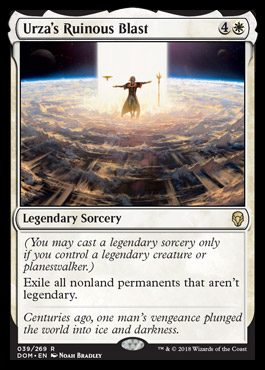
Urza offers a conditional five-mana Planar Cleansing. That’s pretty good in the abstract, but the condition is rough. Obviously, there will be spots where you can cast a legendary creature on turn four and then wipe out three opposing creatures on turn five, butthat seems hard to pull off. Yes, you get to keep you own legends after casting Urza’s Ruinous Blast, but so does your opponent. That will probably be an issue, considering that legendary creatures tend to be good. Your opponent might only have two or three, but they might be exactly what you need to sweep away.
This wipes out other permanents, including sagas. In limited, that rarely matters, except for white enchantment-based removal spells. Pacifism and the creature it enchants both get exiled here, but Oblivion Ring ends up giving their creature back. We shall see what removal white has once the full set is revealed, but this intra-color non-bo has made Planar Cleansing less than great in previous limited environments.
Ultimate verdict: decent card but probably not worth building around. Sweepers need to be reliable, and this is not.
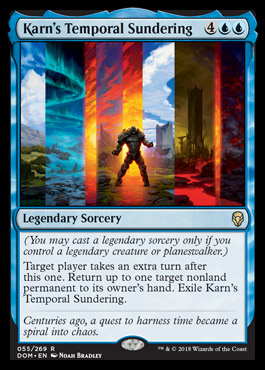
Time Walk plus Disperse sounds like a great deal, even for six mana. Bounce their best blocker, attack with your sweet legendary creature plus whatever else you have, and then do it again before they untap. The spell even has two targets, so you can’t get blown out if they remove the permanent you target. Tempo blue decks would love this effect, and it would be similar to Sea God’s Revenge as a limited finisher.
How hard is it to use this? Well, if you can get up to five or six legendary creatures, you can likely have one in play before you top your curve with Karn’s Temporal Sundering. Blue legends probably don’t pack a big punch, but that’s why you play green or red to add some power to the board.
Ultimate verdict: this one looks good.
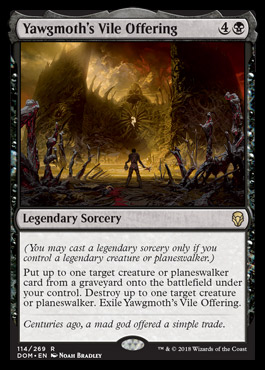
Reanimate plus Hero’s Downfall? That is a ton of value for five mana (and no life payments). You can’t get back what you kill, but that’s fine. This is a game-winning card in limited, assuming you can cast it. In the games where you do it on turn five or six, you probably can’t lose. Even on turn ten or fifteen, this is still great. It might even be better, and this is a card you can sit on for a while. Of course you have to keep your legendary creature around, so you might want to fire this off when you have a good opportunity.
Ultimate verdict: too much value to resist. And it’s splashable!
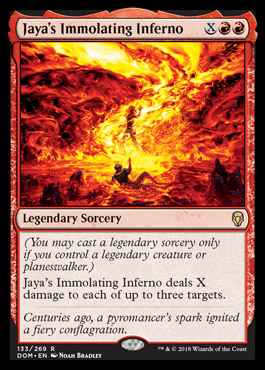
Jaya’s Immolating Inferno is mostly a better version of Rolling Thunder. That is a powerhouse limited card. Rolling Thunder offers total flexibility, including the ability to hit a bunch of 1/1s or pop off a creature or two on turn four. In return for messing around with a legendary creature, the inferno gives you more damage. It’s still a Fireball to the face on turn fifteen, though not on an empty board. If you manage to kill three creatures on turn five, go ahead and retire.
Ultimate verdict: This is the card Urza’s Ruinous Blast wishes it were. Pick up those legends and fire away!
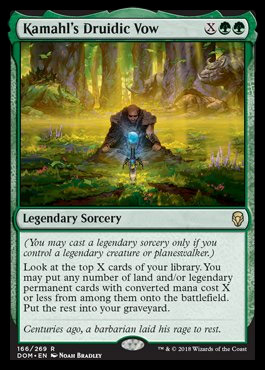
This card looks amazing in a constructed deck build around it, especially in a format that rewards playing a wide variety of creatures. In limited, I’m not so sure. Are you looking forward to sinking seven mana into this, getting three lands and a second copy of the legendary creature you already have in play? Be sure to attack first for “vigilance” value.
I just don’t see a limited deck having enough distinct legendary permanents to hit. This at least can play a legendary artifact or enchantment, if you happen to have one. But for the most part, this is a ramp spell that might hit one or two creatures. Genesis Wave, this is not. If you can scry a giant legend on top of our deck, go for it I guess.
Ultimate verdict: pass this one around the table unless you want to raredraft it.
Carrie O’Hara is Editor-in-Chief of Hipsters of the Coast.

